By Jeffrey A. Rendall, Images courtesy of TaylorMade Golf
CARLSBAD, CA – If you asked a hundred golfers to name the first thing that pops in their heads when you say ‘TaylorMade golf clubs,’ you’d likely get all one hundred answering the same way: ‘drivers and metal woods.’
This golfer would concede that he’d immediately jump in with the ‘drivers’ response, because let’s face it, TaylorMade’s made a huge splash over the years with its innovative metal woods that perform great at all levels of golf from the beginner on the range all the way up to the highest professional levels.
That impression could be changing, however, as TaylorMade’s making inroads in just about all club manufacturing categories, including ironically enough, short-game products. Who would’ve thought that a company focused on hitting the long ball would also be adept at hitting, well… the ‘short ball’ too?
Brian Bazzell, TaylorMade’s Product Creation Manager for Irons and Wedges acknowledges the distance contradiction, but says the company’s going to be known for more than metal woods in the not-so-distant future: “Metal woods are certainly the lifeblood of our company, but I’d say over the last five years that we’ve put a lot of energy into some other categories – not only promoting the products, but also resource-wise and making sure we’re designing the best products.”
Bazzell continues, “It’s shown up already, certainly in the irons category (where TaylorMade’s Burner irons are America’s top seller), but also with putters such as the Monza Spider (discussed below), and now with our revolutionary new exchangeable face wedges that we’re launching. You’re going to see more promotion of our wedges than you’ve seen in the past, because we definitely have the right product at the right time.”
There’s no doubt, wedge-talk is huge in 2010, mostly because of the USGA’s recent rule change which outlaws what Bazzell calls ‘aggressive grooves’ – grooves that are designed to give maximum spin to your wedges. The USGA decided that these clubs gave too much of an advantage to players in the short shots, and acted accordingly.
Wedges are perhaps the prehistoric organisms of golf club design, having changed very little over the past 80 years, according to Bazzell. There’ve been the evolution of different shapes and sizes of wedges, but the biggest single change is in something that isn’t obvious to the naked eye: grooves. As a result of these continuous breakthroughs in technology, manufacturers became so proficient at getting wedges to spin that the powers-that-be thought a rule change was necessary.
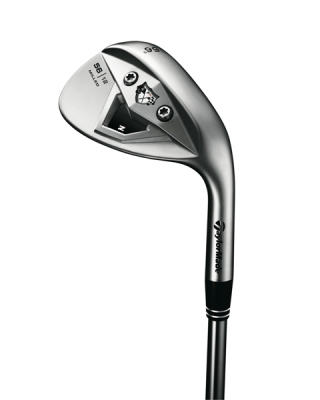 |
“Simply put, it’s an area change, so that the area of the new groove is smaller,” Bazzell said in explaining the difference between the old and the new. “And the radius of the edges are not as sharp in the new wedges.”
“It’s still a U-groove, whereas some people have been calling the new grooves V-shaped (which they can be). In our case we found the optimum groove for the rules is still basically a U-groove, smaller in area and with edges that are not as sharp. It doesn’t sound like much of a change, but when the area of the grooves gets smaller, there’s less room for debris to channel away – and if you’re not channeling away the debris, the ball will not interact with the groove as much as it did before,” Bazzell lectured.
Less contact with the groove means less spin, even if it’s a microsecond’s difference. The ball now has a tendency to slide up the face of the wedge – and the variation in performance will be seen through higher launch angles and lower spin. Translation? Hitting the ball in the rough will be more of a penalty because you’ll have a heck of a time getting the ball to spin and stop on the green without the help of those ‘aggressive’ grooves.
Amateur golfers needn’t worry in a sense – at least not immediately. Bazzell says the rule change applies only to pros in competition at present, so you can still use your ‘aggressive’ grooves until 2024 at your local club. In other words, there’s no immediate need to toss your wedges in the dumpster or donate them to a museum.
Further, manufacturers will continue making wedges with the ‘old’ aggressive grooves for at least a little longer, and they’ll be available through the end of 2010 (manufacturers can ship them through the end of this year, and you’ll have a hard time finding them after they sell out sometime in 2011). After that, you’re going to have to hold onto them for that little extra spin advantage – or buy one of the new adjustable TaylorMade wedges (and a healthy supply of ‘aggressive’ groove face replacements).
When Bazzell mentioned the company was coming out with an adjustable wedge, I thought it sounded a bit impossible, but after seeing photos of them (and having used TaylorMade’s adjustable system in metal woods), I became a believer.
(Editor’s note: At time of writing, the wedges were just beginning to appear in stores, so we hadn’t tried them yet.)
Because you can literally change the face of the wedge, you have two options when buying one – a face with the ‘old’ aggressive grooves, or a face that incorporates the new grooves. It’s an ingenious compromise – you get the best of the old, and can still conform to the new rules with just a few turns of the wrench (there are two screws on the back of the wedge, and it takes about two minutes to change the face).
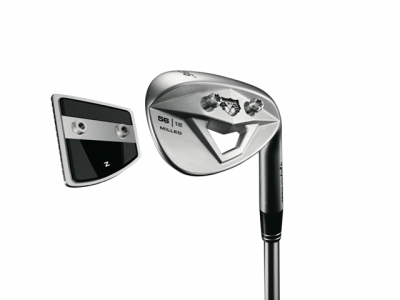 |
Players can also buy a new ‘face’ when needed for about the same price as a box of golf balls. Not bad – it even increases the durability of the product.
How often to change? “We recommend that you change the face roughly every 15-20 rounds, depending on where you’re playing, what ground conditions are like and how many balls you’re hitting,” Bazzell said. “On Tour, we’re going to see guys switching out every week, some every month. But with this wedge technology, they’re going to get dialed in with their wedge, with the right bounce and the right shape – and all they have to do is pop in a new face to keep it fresh.”
For our purposes, we tried out a couple of TaylorMade’s top ‘aggressive’ grooved wedges from the RAC Satin TP line, a 54 degree ‘gap’ wedge and a 58 degree sand wedge. Like all of TaylorMade’s products, we found them to be extremely pleasing to the eye and high in quality, right off the rack.
On the golf course, they performed well under a wide range of conditions and turf types (and sand, of course), from around the greens to short fairway cut to deep rough and even some ‘out of play’ conditions.
The most inspiring thing about them was the confidence they instilled when pulling them from the bag – and considering the number of times you typically use wedges during every round, that’s important. Your wedge almost becomes your best friend when playing golf, and you’d better maintain a healthy relationship – and the RAC Satin TP wedges do just that.
We’re certainly looking forward to seeing and trying the adjustable wedges as well.
Monza Spider Putter
“It looks like something right out of outer space,” commented a playing partner during a recent golf round, after gazing at the TaylorMade Monza Spider putter I’d brought to the green.
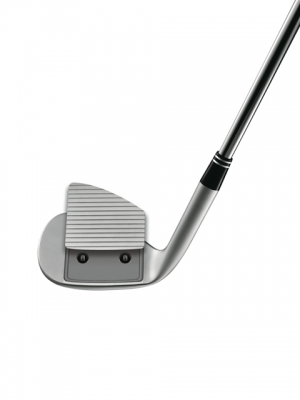 |
It’s true, the Monza Spider doesn’t really look like anything that’s quite ‘of this world,’ at least in the golf sense, but what it lacks in traditional beauty, it makes up for in pure performance. After I’d gotten used to the bizarre shape of the putter and just started rolling the ball, however, I quickly forgot about its somewhat ‘shocking’ first impression and just marveled at how easy it was to use it.
Don’t get me wrong – no putter is perfect, and I’ve had good success with most of the putters I’ve tried recently, but the Monza Spider really made an impression – and not just from an aesthetic standpoint.
I was curious about its strange geometric shape, and asked TaylorMade’s Bill Price (Senior Director of Putters and Golf Balls) to attempt to explain it: “It’s true that many golf manufacturers are coming out with some strange looking putters these days, and the reason is these are all high MOI (moment of inertia) putters which provide a better sweetspot over conventional putters.”
Price continues, “What makes the Spider better is a combination of MOI, roll and stability. For stability, the Spider offers the best weight distribution (heel-toe) for impact stability. This is accomplished with a multi-material head. The Spider also has a higher MOI for impact forgiveness. The sweetspot is larger to provide golfers the same rollout on off-center hits.”
“Finally, the Spider offers the best roll with AGSI (Anti-skid Groove System Insert) technology to provide forward roll with less backspin,” Price added.
It’s hard to believe that putters used to be just a chunk of metal pounded out and shaped with a flat face. Now they’re high-tech pieces of equipment designed to roll a ball with as little bounce as possible – and a better and more consistent roll means more putts in the hole.
As you’d probably expect, AGSI technology (which is incorporated into the red face of all Monza putters) sounds pretty complicated. Price again sheds light on it: “The red face you see is a Titallium insert that contains 14 grooves to reduce skidding and promote precise line direction and optimal speed control. The result was better performance and forward spin (not backspin) on the greens.”
It’s the opposite orientation to irons, which rely on backspin to stop the ball at a certain yardage, enhancing distance control. But I digress.
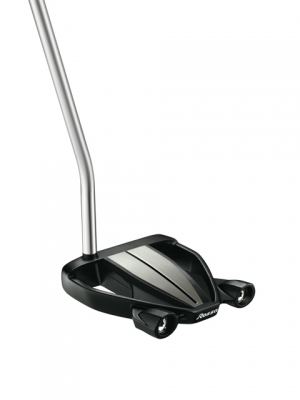 |
“The soft aluminum (Titallium) insert is polymer-filled for better feel. When the putter contacts the ball, the polymer-filled grooves give way to expose groove edges. This minimizes backspin (skid) delivering optimal speed control and directional stability. The result? More putts made,” Price said proudly.
Titallium is a seven-metal alloy that’s lighter (65% lighter than steel) and is more durable than other metals. Titallium is employed in Rossa putters because it allows engineers to save weight in the middle of the clubface and can be redistributed to other areas of the clubhead to improve MOI and greater forgiveness on mis-hits – and it also moves the center-of-gravity to lower and deeper in the clubhead, which improves launch conditions and provides a better roll.
Price says the AGSI + insert also employs a unique structural groove design developed to drastically reduce skid – which allows the ball to start rolling sooner off the clubface on a true path along with improved directional and distance control. The active grooves also grabs the ball cover and increases the face friction to impart proper launch and forward spin.
I noticed the Spider also has what appear to be weights – something that shows up in many of TaylorMade’s movable-weight capable metal woods. Price says they are indeed replaceable – which allows another level of customization to the Spider, providing players with the ability to get the head weight feel just right.
As stated earlier, the Spider’s bizarre looks are enough to throw just about any traditionalist off at first glance – and Price acknowledged that appearances can make all the difference to some folks. “There will be customers who will not try the putter, but getting the ball into the hole is what matters, not the looks of the putter. This is strange because these same customers are always looking for NEW technology in their drivers and irons, but want to stay conventional with their putters.”
It is strange. But I can understand it, because I’m a traditionalist and the Spider’s unique shape gyrations are anything but ordinary.
The ultimate test comes on the greens, however, and there the Spider is as good as Price says it is – I’ve thoroughly enjoyed using it, and can honestly say that I’ve putted well with it.
Taken together with TaylorMade’s latest wedges, it’s clear that the ‘short ball’ is getting a good deal of attention by the company’s design team these days.
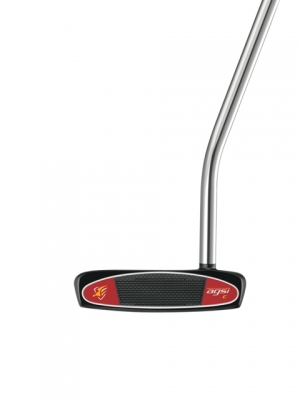 |
Details:
TaylorMade’s Wedges and Putters
Available at your higher-end golf retailers and club pro shops.
Check out more information about TaylorMade products at: www.taylormadegolf.com.
TaylorMade became famous for pioneering metal woods, but the company now produces everything from metal woods to wedges to putters. And since joining with Adidas (and Ashworth), don’t forget footwear and clothing. Check out the website for more information.
| Related Links | Comments on this article? | |
|
Maryland National Golf Club Hollow Creek Golf Club Rocky Gap Resort PB Dye Golf Club in Ijamsville Whiskey Creek Golf Club |
E-mail Jeff Rendall, Editor: jrendall@golftheunitedstates.com |












